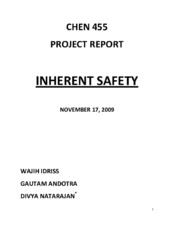| dc.description.abstract | It is a known fact that prevention is always better than control but traditionally safety measures
within the field of engineering is usually applied to control the hazards rather than reducing
them. This approach based on controlling a hazard is often referred to as ‘extrinsic safety’ as opposed to the approach of reducing the presence of a hazard, which is called ‘inherent safety’15.
The concept of inherent safety comes from theories formulated by Trevor Kletz, in his article,
entitled “What You Don’t Have, Can’t Leak. Years later in 1991, Mr. Kletz published a more
updated version of his studies titled “Plant Design for Safety – A User-Friendly Approach”,
which gave rise to the modern concepts of inherent safety. Inherently safer design has been
advocated since the explosion at Flixborough in 1974, which raised a lot of question about safety
in chemical plants.
As mentioned earlier an inherently safer design is one that avoids hazards instead of
controlling them, particularly by removing or reducing the amount of hazardous material in the plant or the number of hazardous operations21. Hazards can be reduced or eliminated by
changing the materials, chemistry, and process variables such that the reduced hazard is
characteristic of the new conditions and such a process with reduced hazards is described as
inherently safer. Inherent safety recognizes there is no chemical process that is without risk, but
all chemical processes can be made safer by applying inherently safer concepts. Therefore in
order to reduce the hazards we need to be able to understand the various concepts of inherent safety, more commonly called ‘inherently safer design strategies’21. The inherently safer design
strategies have been grouped into four major strategies:
6
1. Intensification: Using smaller quantities of hazardous substances.
2. Substitution: Replacing a material or a process with a less hazardous one.
3. Simplification: Designing facilities which eliminate unnecessary complexity.
4. Attenuation: Facilities which minimize the impact of a hazardous release. | en |




